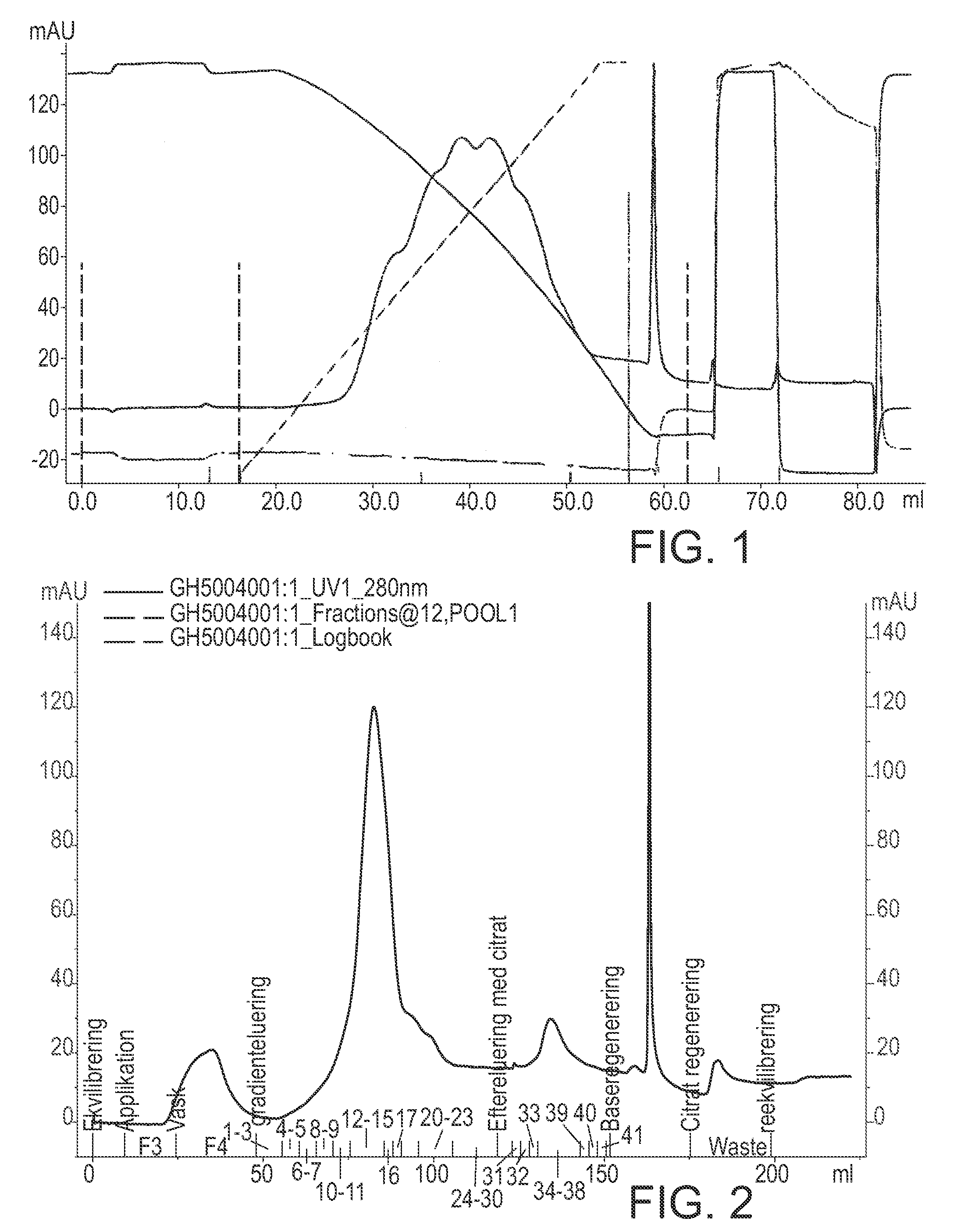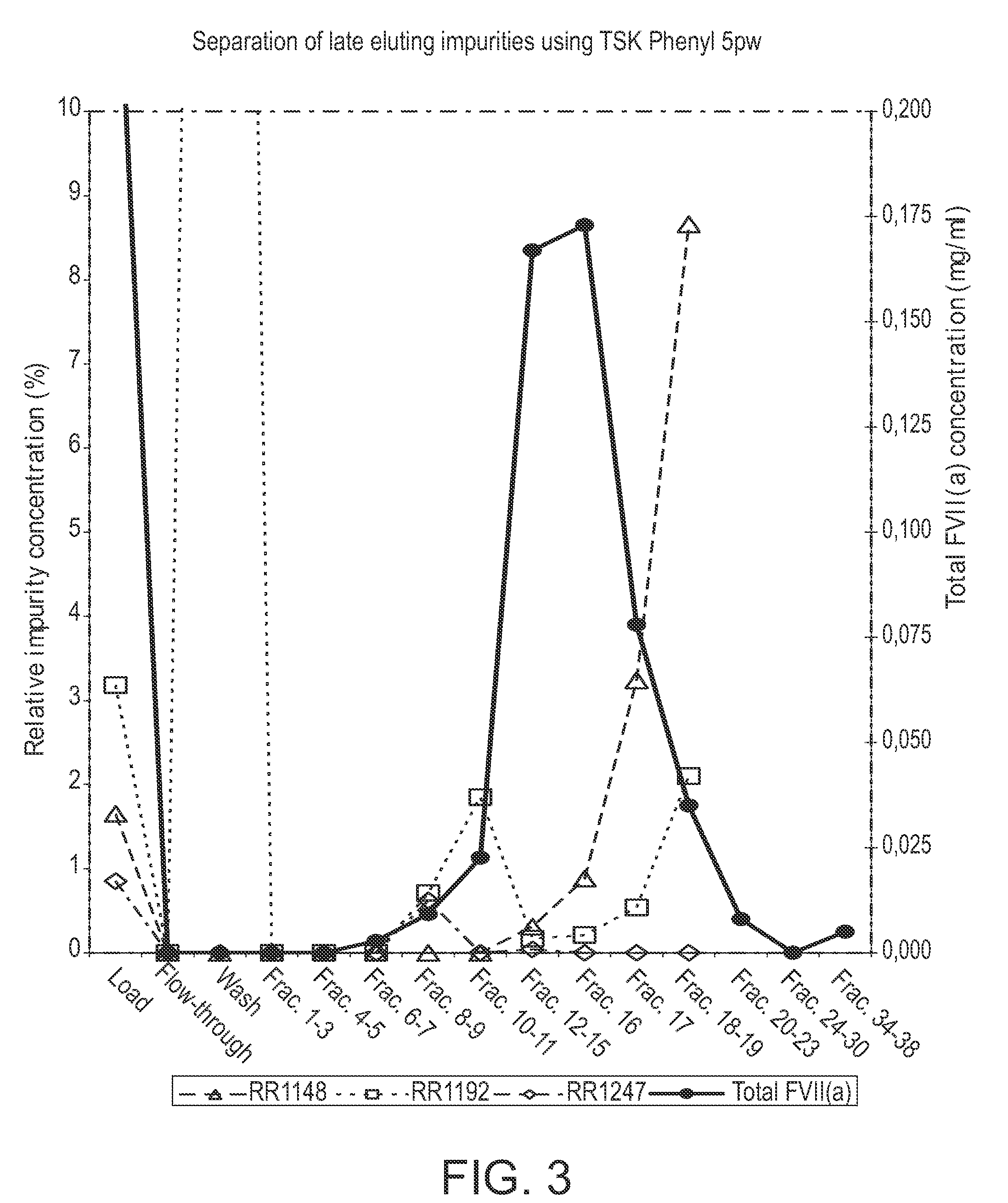Hydrophobic interaction chromatography purification of factor vii polypeptides
a chromatographic method and hydrophobic interaction technology, applied in the direction of peptide/protein ingredients, drug compositions, extracellular fluid disorder, etc., can solve the problem that polypeptides may not have uniform glycosylation patterns, and achieve the effect of reducing or virtually eliminating the presence of late elution peak in drug substances
- Summary
- Abstract
- Description
- Claims
- Application Information
AI Technical Summary
Benefits of technology
Problems solved by technology
Method used
Image
Examples
example 1
Reduction of Heavy Chain Degraded and Oxidized rhFVII by HIC Purification of rhFVIIa at DH 6 Using TSK Phenyl 5PW
[0171]5 mg of highly pure recombinant hFVIIa was added NH4-acetate to a final concentration of 1.8 M and CaCl2 to a final concentration of 10 mM and methionine to a final concentration of 10 mM. pH was adjusted to pH 6.0. This sample was added to a column (0.5 cm in inner diameter×10.0 cm length=2 ml column volume (CV)) packed with Toso Haas TSK-Gel phenyl 5 PW, equilibrated with 5 CV 1.8 M NH4-acetate, 10 mM CaCl2, 10 mM methionine, pH 6.0 (load 1.6 g / L). The column was washed with 3 CV 1.8 M NH4-acetate, 10 mM CaCl2, 10 mM methionine, pH 6.0. Elution was performed using an 18 CV linear gradient from 1.8 M NH4-acetate to 50 mM NH4-acetate in a buffer containing 10 mM CaCl2, 10 mM methionine at pH 6.0. Though peak collection at approximately 65% of maximum absorbance (at 280 nm) on the leading edge and at approximately 20% of maximum absorbance on the trailing edge a pool...
example 2
Performing Hydrophobic Interaction Chromatography
[0175]A sample of rhFVII is added (NH4)2SO4 to a final concentration 1 M. pH is adjusted to pH 8.6 buffered with 20 mM Tris. This sample is added to a column packed with Toyopearl butyl 650S, equilibrated with 5 CV 1 M (NH4)2SO4, 20 mM Tris, pH 8.6. The column is washed with 5 CV 1 M (NH4)2SO4, 20 mM Tris, pH 8.6. Elution is performed using a 20 CV linear gradient from 1.0 M (NH4)2SO4 to 0 M (NH4)2SO4, in a buffer containing 20 mM Tris, pH 8.6. A FVII containing pool is selected through peak collecting. Heavy chain degraded and oxidized rhFVII is reduced due to their lower retention time compared to native rhFVII. The late eluting peaks 1, 2 and 3 are reduced due to their relatively higher retention time compared to the native rhFVII.
example 3
Reduction of Late Eluting Peaks by HIC Purification of FVIIa Analogue at pH 6 Using TSK Phenyl 5PW
[0176]A 4.7 ml column was packed with TSK Phenyl 5PW (20 μm) resin and equilibrated with 20 CV of a buffer containing: 2.0 M Ammonium acetate, 10 mM CaCl2, 10 mM Histidine, pH 6.0.
[0177]A load consisting of 15 milliliters of 0.25 mg / ml FVIIa analogue in 2.0 M ammonium acetate, 10 mM CaCl2, 10 mM Histidine, pH 6.0 was loaded onto the column, corresponding to a specific load of 0.8 mg / ml resin. The column was washed using 5 CV of the equilibration buffer. The elution was performed using a linear gradient from the wash and equilibration buffer to 10 mM CaCl2, 10 mM Histidine, pH 6.0 over 10 CV followed by a 5 CV hold. 5 ml fractions were collected across the elution peak. The chromatogram is illustrated in FIG. 3.
[0178]The column was regenerated using 5 CV's of 50 mM tri sodium citrate, pH 7.5 followed by 5 CV's of 1.0 M sodium hydroxide. The flow rate was 6 CV / h throughout the purificatio...
PUM
| Property | Measurement | Unit |
|---|---|---|
| Temperature | aaaaa | aaaaa |
| Fraction | aaaaa | aaaaa |
| Fraction | aaaaa | aaaaa |
Abstract
Description
Claims
Application Information
 Login to View More
Login to View More - R&D
- Intellectual Property
- Life Sciences
- Materials
- Tech Scout
- Unparalleled Data Quality
- Higher Quality Content
- 60% Fewer Hallucinations
Browse by: Latest US Patents, China's latest patents, Technical Efficacy Thesaurus, Application Domain, Technology Topic, Popular Technical Reports.
© 2025 PatSnap. All rights reserved.Legal|Privacy policy|Modern Slavery Act Transparency Statement|Sitemap|About US| Contact US: help@patsnap.com



